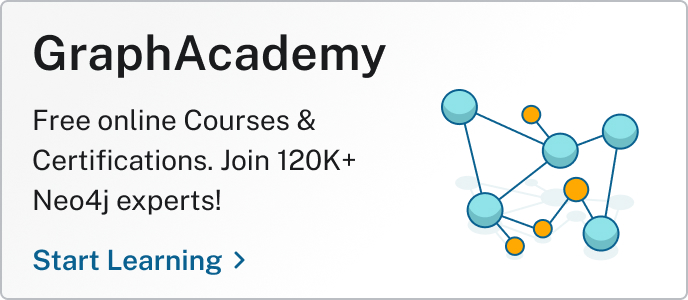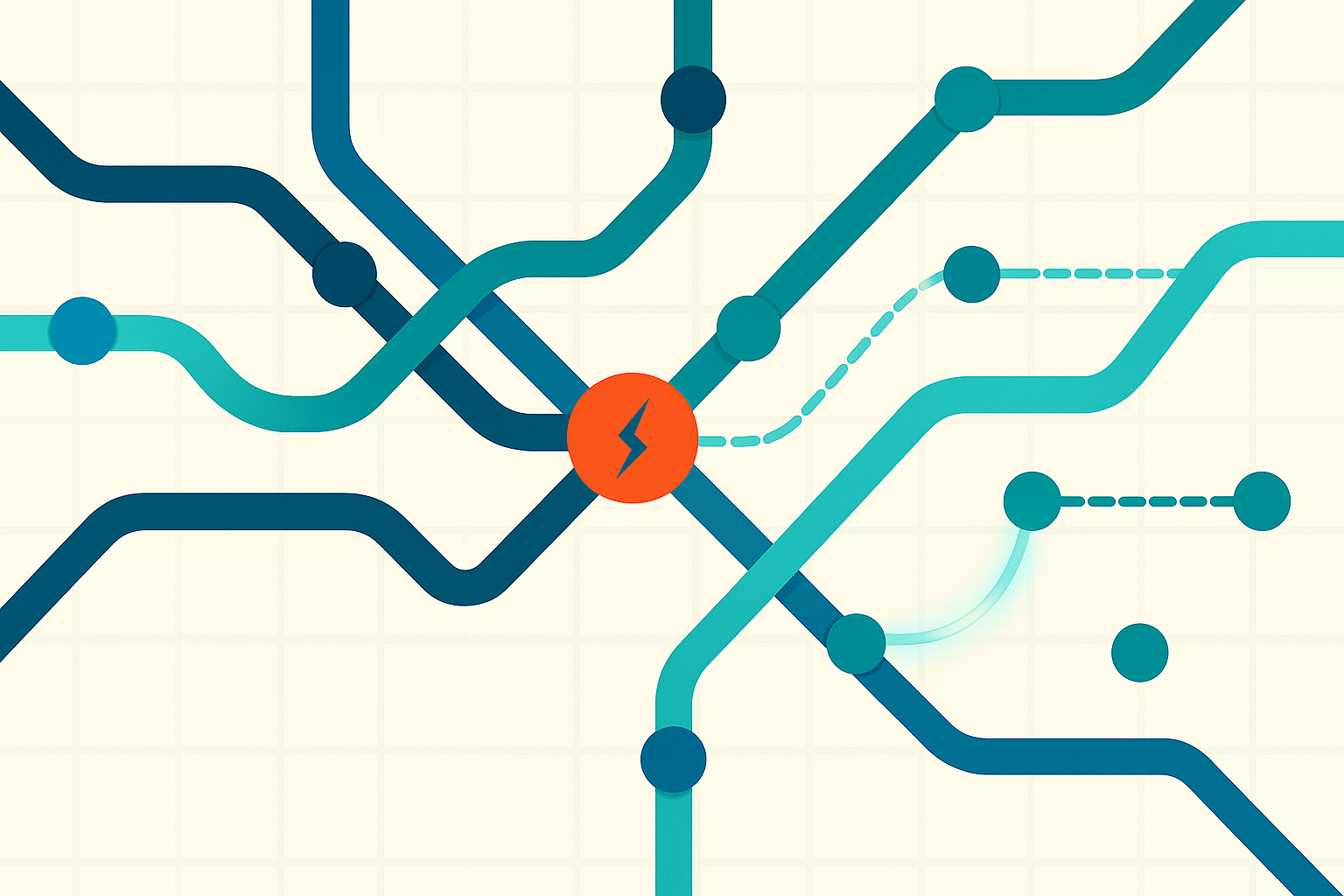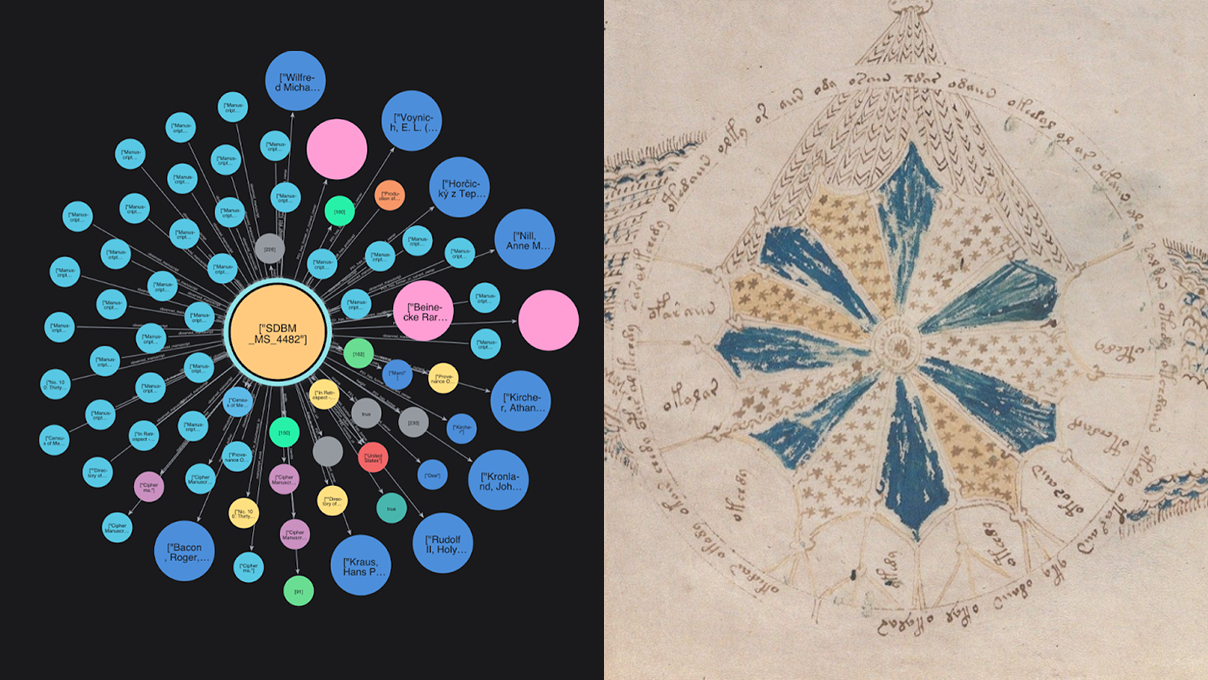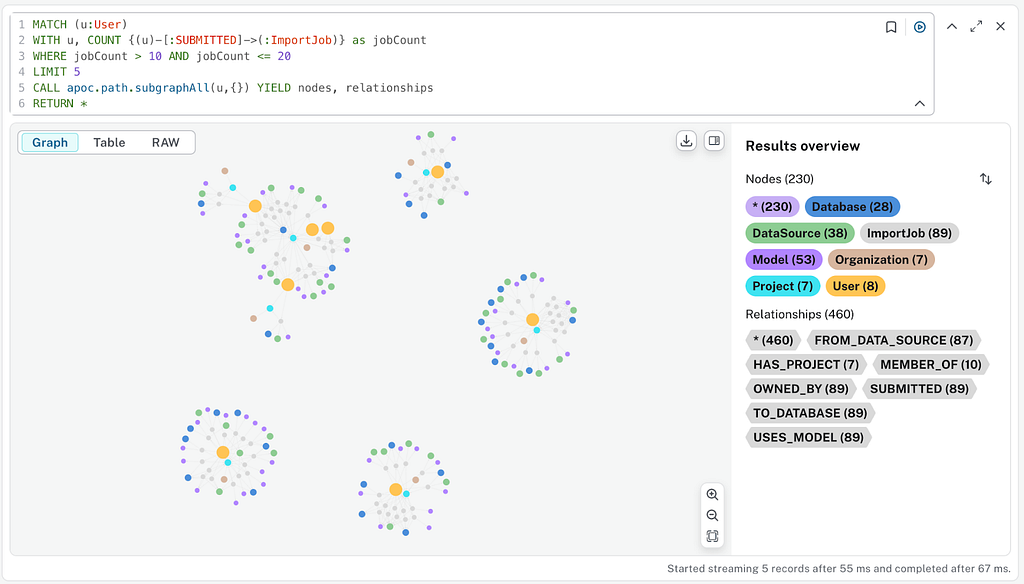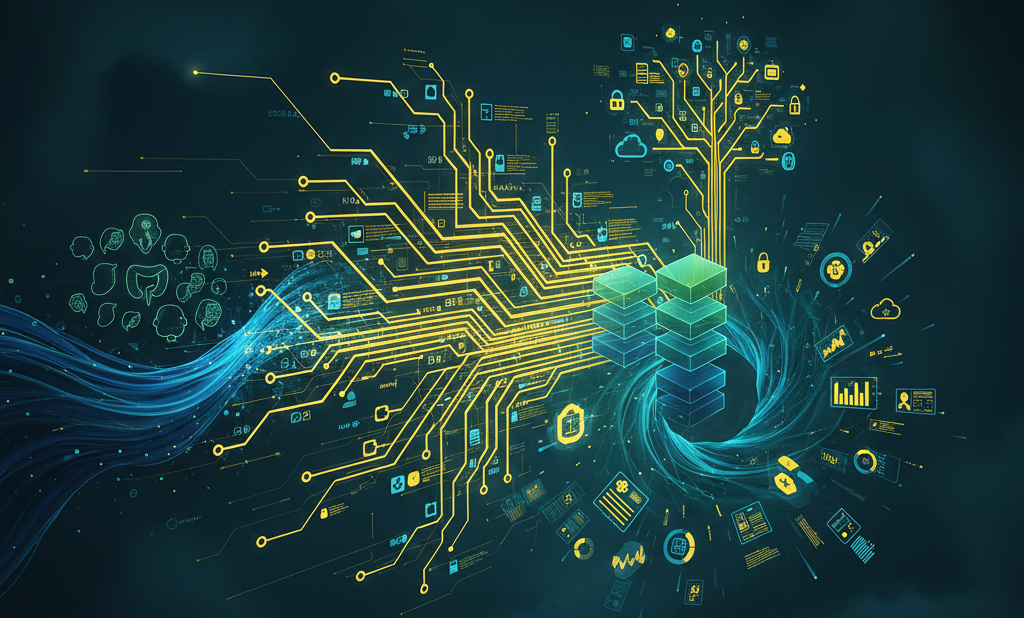Graph Analytics Applications and Use Cases
14 min read

Organizations often struggle to generate powerful insights from connected data because traditional analytics isn’t designed to handle complex relationships within large datasets. To make truly informed decisions, you have to understand the key connections in your data — whether you’re trying to detect fraud, improve recommendations, protect sensitive data, or optimize supply chains.
Graph analytics helps reveal hidden patterns, trends, and anomalies by analyzing relationships between data entities. It also helps make predictions and generate insights that traditional analytics methods might miss.
In this guide, you’ll learn how graph analytics turns data challenges into opportunities. You’ll explore impactful real-world applications for graph analytics and learn how Neo4j can simplify complex data analysis and quickly deliver production-ready insights.
Fraud Detection and Risk Analysis: Navigating Complex Fraud Schemes
Banks, retailers, telecommunications companies, and ecommerce businesses all deal with security risks like synthetic identity fraud, account takeovers, and sophisticated cross-channel attacks. Organizations can unmask fraud rings and cybercriminal networks, and limit or prevent the damage they do, by identifying the connections between malicious actors and their activities, such as shared IP addresses, matching device fingerprints, and coordinated transaction patterns. Unfortunately, those connections often remain invisible in traditional relational database architectures, which enforce rigid table structures and can’t represent complex relationships without expensive JOIN operations. Bad actors exploit these structural limitations — specifically, schema rigidity and JOIN-related performance constraints — by distributing suspicious activities across multiple accounts and channels.
These architectural constraints create systems that:
- Depend on predefined rules and can’t adapt to evolving fraud tactics
- Produce false alerts because they analyze connections without sufficient context
- Fail to detect coordinated fraud activities across different platforms or services
Enter Neo4j Aura Graph Analytics, which can help solve the core technical challenges faced by traditional fraud detection systems that use relational databases. In the table below, you’ll find the impact Neo4j Aura Graph Analytics can have on fraud detection.
| Relational Database Limitation | Fraud Detection Impact | Neo4j Graph Advantage |
|---|---|---|
| Fixed schema requirements | Requires costly data model redesign for new fraud patterns | Flexible schema adapts to emerging threat patterns |
| JOIN-intensive queries | Exponential performance degradation with connected data analysis | Native relationship indexing enables real-time pattern matching |
| Multihop relationship analysis | Computationally prohibitive at scale | Constant time traversals regardless of path depth |
Use Case: Identifying Money Laundering Circles
Graph algorithms track transaction flows between accounts to uncover potential money laundering activities. For example, a rapid succession of transfers between unrelated accounts across multiple regions can signal suspicious behavior. Graph databases such as Neo4j AuraDB model accounts as nodes and transactions as relationships, detecting cycles, clusters, and “hub” accounts.

This visualization shows a classic money laundering scheme:
- International transactions across multiple jurisdictions (United States, China, Russia, Brazil, India, Cayman Islands)
- A central hub account in a tax haven (Cayman Islands)
- Circular flow of money that eventually returns to the source
- Slightly decreasing amounts (stripping) at each transfer
- Rapid succession of transfers (all occurring within hours)
Neo4j Aura Graph Analytics streamlines de-duplication and entity resolution by identifying similar entities and their relationships. You can model your data entities (customers, accounts, devices, etc.) as nodes that possess properties (name, address, email, etc.), then create relationships between these entities to represent their interactions or connections. This approach lets you see how entities are linked across your data ecosystem, uncovering patterns that traditional databases often miss. For example, if you have two customer records with slightly different names but identical transaction patterns with the same merchant accounts, you can flag them as potential duplicates.
Unlike traditional relational databases that struggle with JOIN-intensive operations across large datasets, Neo4j’s solution efficiently analyzes relationships within large datasets, scaling to millions of entities without performance issues.
Neo4j Aura Graph Analytics also enables sophisticated fraud detection using a combination of probabilistic community detection and similarity algorithms. The platform’s Weakly Connected Components algorithm groups accounts that share suspicious attributes to reveal hidden connections across seemingly unrelated entities.
Similarity algorithms such as Jaccard, Cosine, and Overlap help detect synthetic identities by measuring how closely different entities match across multiple dimensions. For instance, Jaccard similarity can flag potential synthetic identities constructed from stolen data fragments by identifying unusual combinations of legitimate identity components. This approach generates real-time fraud risk scores without the performance degradation of complex JOIN operations, allowing financial institutions to act immediately.
To learn more about how to combat money laundering using Neo4j graph technology, read this in-depth guide. If you want to take a deeper look at fraud detection with Neo4j, check out this blog series.
Recommendation Engines: Enhancing Customer Engagement Through Relationships
Ecommerce and streaming services struggle with traditional recommendation systems. Most use collaborative filtering to recommend items based on user similarities or past interactions. This approach often fails to identify complex relationships, such as how different products or user behaviors are connected beyond frequency or history-based patterns.
Traditional systems also struggle with the “cold-start” problem and rely on static historical data, limiting truly personalized experiences.
Use Case: Personalized Content Recommendations
Streaming giants like Netflix and Spotify are great examples of how graph-based recommendation engines can provide superior personalization experiences. Netflix analyzes not just what you watch but how you watch it — including viewing duration, time of day, and device used—to create a complex network of interconnected data points.
Similarly, Spotify uses a knowledge graph that represents music entities (songs, artists, albums) and their relationships (genres, moods, artists) to deliver its Discover Weekly playlists. By analyzing both content attributes and user behavior within a graph structure, Spotify can make connections between seemingly unrelated musical preferences that traditional tabular databases would miss.
Here’s how a streaming platform might use a graph-based approach to design a recommendation system:

This diagram illustrates a streaming platform network with interconnected users, shows, completion rates, and devices. A graph-based approach uncovers deep relationships between these entities, enabling the platform to build a context-aware recommendation system.
With more than 65 built-in graph algorithms, such as Personalized PageRank and K-Nearest Neighbors, Neo4j Aura Graph Analytics enhances recommendation accuracy by analyzing relationships across multiple dimensions. These algorithms use graph structure to score items based on proximity, influence, and similarity, delivering personalized suggestions at subsecond speeds and improving engagement metrics. Neo4j also reduces development cycles with its flexible schema and scalable architecture.
By modeling users, items, and interactions as nodes and relationships, Neo4j simplifies complex queries and provides real-time adaptive recommendations. It’s an ideal solution for modern recommendation engines.
Supply Chain Optimization: Mastering Complex Network Relationships
Manufacturing, retail, logistics, pharmaceutical, and food companies struggle with supply chain challenges. Gaps between supply chain tiers make visibility a constant issue, while traditional database systems slow things down. When disruptions happen, businesses often can’t quickly pinpoint affected products or find backup suppliers. Traditional systems aren’t built to handle the highly connected nature of modern supply chains because they use rigid schemas to store supplier and logistics data, which makes it difficult to analyze interdependencies.
Graph analytics models supply chains as real-world networks of interconnected entities. The Neo4j Aura database allows supply chain managers to traverse multiple tiers of suppliers, distribution centers, and transportation routes with consistent performance regardless of network depth. This enables real-time impact analysis during disruptions, as well as proactive risk management that traditional relational database systems simply cannot match at scale.
Use Case: Risk Mitigation and Route Optimization
By modeling factories, distribution centers, ports, and transportation routes as an interconnected graph, manufacturers can identify optimal shipping paths while quickly detecting and avoiding potential bottlenecks.
Let’s see how a global manufacturer can optimize its supply chain with Neo4j. The scenario below illustrates how a company facing visibility challenges across its multi-tiered supply chain can use graph analytics to model its entire supply network as a graph, gaining insights into:
- Dependencies on second- and third-tier suppliers
- Critical paths for component delivery
- Concentration of risk in particular geographic areas
- Alternative sourcing opportunities when disruptions occur

Neo4j’s graph model enables rapid impact assessment and alternative supplier activation, with shortest-path algorithms optimizing routing in milliseconds. Meanwhile, betweenness centrality pinpoints critical failure points, like a single port handling 80 percent of deliveries.
Neo4j Aura efficiently analyzes supply chain data, from inventory and transit times to external risks.
Cybersecurity and Threat Detection: Mapping Digital Threat Landscapes
Financial services, government agencies, and critical infrastructure sectors face sophisticated threats that deliberately mimic legitimate behavior while moving laterally through networks. These threats evade traditional detection thresholds that rely on known attack patterns.
Graph analytics models security data as interconnected entities and events rather than as isolated alerts or logs. By representing users, devices, IP addresses, and network activities as nodes and relationships, Neo4j can track attack patterns as they unfold across networks and over time. This relationship-centric approach enables security teams to detect lateral movement, privilege escalation, and data exfiltration attempts that traditional security information and event management (SIEM) systems miss.
Neo4j Aura Graph Analytics algorithms can identify subtle connections between seemingly unrelated events to reveal coordinated attacks that would otherwise remain hidden in the noise of billions of daily security events.
Use Case: Counteracting a Phishing Campaign
Financial institutions face increasingly sophisticated phishing campaigns where attackers impersonate legitimate entities to gain unauthorized access to sensitive systems. These attacks typically involve multiple touchpoints — spoofed emails, fake websites, and social engineering tactics — that make them difficult to detect with traditional security tools. When successful, these campaigns can lead to credential theft, account takeovers, and ultimately data breaches that impact thousands of customers.
The challenge for security teams lies in connecting disparate indicators across multiple systems and time periods to identify coordinated campaigns before they succeed. Traditional SIEM systems struggle to identify these complex attack patterns because they rely on predefined correlation rules that cannot adapt to novel attack techniques.
Security teams can overcome these challenges by consolidating disparate security data into a comprehensive graph model. Unlike supply chain modeling that focuses on physical entities, cybersecurity graphs integrate accounts, devices, applications, and network resources with their access relationships and interaction events. Moreover, the Neo4j LLM Knowledge Graph Builder can extract entities and relationships from unstructured security logs and threat intelligence reports.

With this holistic view of security data, a financial company can map IP addresses, device fingerprints, and login attempts to detect hidden connections.
For example, despite attackers rotating IP addresses to avoid detection, a graph analysis might reveal a cluster of accounts accessed from a single device with suspicious characteristics. By traversing the graph, security teams can trace the attacker’s lateral movement through the network, identifying every account, system, and dataset potentially compromised in the campaign.
Neo4j’s centrality algorithms can spot important resources that might be targeted by attackers. For instance, PageRank can identify highly connected servers with excessive privileges, whereas Label Propagation can help detect groups of compromised user accounts showing similar behavior patterns. These algorithms operate efficiently regardless of database size, enabling real-time threat hunting across petabytes of security data without the performance degradation that would cripple relational database queries.
Content Networks and Media Intelligence: Navigating Information Ecosystems
Media organizations, news outlets, and content publishers face unique challenges in managing complex relationships between content, topics, entities, and audience interactions. Traditional systems rely on keyword matching, which limits content discovery and insight generation.
Graph analytics transforms content management by modeling the naturally connected structure of information ecosystems. Neo4j enables organizations to create knowledge graphs where articles, topics, people, places, and events exist as an interconnected network rather than as fragmented tables requiring complex JOINs. This approach reveals contextual relationships and patterns that traditional systems cannot detect while maintaining consistent query performance, even with millions of documents.
Use Case: Identifying Misinformation Networks
Misinformation campaigns involve coordinated account networks that appear legitimate when the content pieces they generate are analyzed individually. Traditional moderation systems that focus on isolated content consistently fail to detect these orchestrated efforts.
Neo4j addresses this challenge by transforming unstructured content into rich knowledge graphs where entities and their relationships become visible. For instance, a media intelligence company can analyze millions of social media posts during political events by modeling user accounts, content, hashtags, and engagement patterns as an interconnected graph. This representation immediately surfaces network structures invisible to traditional analytics.
Let’s take a look at a sample graph that maps users, their posts, related hashtags, and different topics to uncover suspicious patterns:

In isolation, each post might look normal, but in a graph, we can identify multihop relationships that reveal coordinated content amplification, shared devices, and repeated use of similar hashtags.
Neo4j’s graph algorithms help analyze user engagement, with the Degree Centrality algorithm identifying influential accounts driving engagement and the Louvain algorithm segmenting users into meaningful communities based on interaction patterns. Most importantly, accounts with high betweenness centrality — those bridging otherwise disconnected ideological groups — can be identified as potential misinformation superspreaders. By focusing moderation efforts on these strategic nodes, platforms can reduce the spread of false information without broad content censorship.
This targeted approach not only curbs misinformation but also provides deeper engagement insights by revealing how users interact within communities and across networks.
Healthcare and Biomedical Research: Uncovering Life-Saving Connections
Healthcare providers, pharmaceutical companies, and research institutions manage vast biomedical datasets that span electronic health records, genomic sequences, protein interactions, and clinical trials. Traditional relational databases fragment data in a way that makes it hard to trace the relationships between diseases, drugs, and patients.
Querying biological relationships in relational databases slows exponentially with path length and makes multistep analysis costly. This fragmentation, combined with rigid schema requirements that complicate the integration of diverse biomedical data formats and ontologies, severely hampers drug discovery efforts and comprehensive patient care.
Graph analytics transforms biomedical research by representing biological systems as interconnected networks rather than disconnected data silos. Neo4j’s schema-agnostic structure seamlessly integrates genomic data, proteomics, clinical records, and research literature into a unified knowledge graph, preserving the contextual relationships that drive medical breakthroughs. Unlike relational databases that require predefined JOIN tables, Neo4j enables constant-time traversal of complex pathways — whether analyzing three-step drug-protein-disease interactions or 10-step metabolic cascades — with no performance penalty for relationship depth. This capability proves critical when connecting disparate data sources like electronic health records and CRISPR screening results, where traditional systems struggle with incompatible schemas and delayed query responses.
Use Case: Drug Repurposing
Drug repurposing, or finding new therapeutic applications for existing approved medications, offers a faster, more cost-effective path to treatment than traditional drug development, which typically takes 10-15 years and billions of dollars. Yet identifying promising repurposing candidates isn’t easy — it requires analyzing complex biological interactions across disparate datasets, including protein-protein interactions, gene expression patterns, pathway analyses, and clinical outcomes. Traditional database approaches struggle with these multidimensional relationship queries, making potential connections nearly impossible to discover systematically.
Let’s look at a sample graph that explicitly models relationships between drugs, diseases, genes, and proteins to identify potential drug repurposing opportunities:

Neo4j can connect thousands of biomedical entities, including diseases, drugs, genes, proteins, and pathways, in comprehensive knowledge graphs. By integrating public and proprietary data, companies can create unified views of biological mechanisms, drug targets, and disease pathways.
Moreover, Neo4j’s Text2Cypher capability helps subject-matter experts conduct sophisticated network analyses using natural language queries, eliminating the need for specialized programming skills. A clinician can simply ask, “Which approved drugs target the same pathway as Gene X that is upregulated in Disease Y?” and receive visually mapped results that highlight potential repurposing opportunities.
When integrated with machine learning frameworks like TensorFlow, Neo4j can enhance drug repurposing through graph neural networks that predict novel drug interactions and side effects. These models use the rich relationship context unique to graph representations to achieve prediction accuracy that’s impossible with traditional tabular data.
IT Infrastructure and Network Management: Mapping Digital Ecosystems
Large enterprises with complex IT infrastructures struggle to model and analyze component relationships across their physical and virtual environments. Traditional tools use static representations that fail to capture the dynamic, interconnected nature of modern technology ecosystems, making it nearly impossible to understand dependencies, trace impacts, and identify critical pathways.
Neo4j Aura Graph Analytics provides the ideal foundation for IT infrastructure management by modeling technology environments as naturally interconnected systems. Neo4j represents servers, applications, network devices, and services as nodes with their dependencies and communication paths as relationships, creating a living map of the entire ecosystem.
Neo4j instantly maps dependencies, unlike configuration management databases built on relational databases that require complex JOINs for simple queries like, “What applications will be affected if this server fails?” This becomes particularly critical in cloud-native environments where container orchestration creates a constantly shifting infrastructure that traditional inventory systems cannot effectively track.
With Neo4j’s real-time relationship modeling, IT teams can instantly visualize blast-radius calculations, perform root-cause analysis, and identify single points of failure that would remain hidden in conventional monitoring tools.
Use Case: Optimizing Cloud Costs
Optimizing cloud infrastructure becomes more difficult as environments grow increasingly complex. Organizations typically struggle to identify unused resources, understand dependencies between services, and safely decommission components without disrupting critical business operations. Traditional cloud management tools provide basic usage metrics but fail to reveal the complex web of relationships between resources. This leads to unnecessary spending on orphaned instances, overprovisioned services, and redundant components. When cost-cutting initiatives are attempted without full visibility into these dependencies, companies risk causing unexpected service outages.
For example, the graph below shows the dependencies for deployed cloud applications, such as databases and compute instances:

Notice that the cloud infrastructure includes an orphan instance, which could be challenging to identify without diving into its usage metrics.
A SaaS provider can address these challenges by using Neo4j to model its entire cloud infrastructure as a connected graph. By mapping dependencies among applications, services, databases, and compute resources, it creates a comprehensive digital twin of its environment that reveals both direct and indirect relationships. Neo4j’s centrality algorithms identify critical pathways and bottlenecks while highlighting orphaned resources still generating costs and underutilized EC2 instances that can be downsized. Most importantly, the graph visualization exposes hidden dependencies between seemingly independent services, enabling teams to safely decommission redundant components without triggering cascading failures.
Neo4j AuraDB’s real-time querying capabilities transform how IT teams monitor and troubleshoot their infrastructure. Unlike traditional monitoring tools that provide only predefined dashboards with limited context, Neo4j enables dynamic traversal of the entire dependency chain from any starting point. When an incident occurs, teams can instantly trace the impact path across all affected services, databases, and applications. For example, depth-first search pathfinding algorithms can quickly trace the root cause of API failures across multiple service layers, dramatically reducing mean time to resolution. This real-time relationship awareness provides the contextual understanding necessary for both proactive cost optimization and reactive incident management — capabilities that flat-file CMDBs and traditional monitoring tools simply cannot deliver.
Conclusion
Graph analytics offers organizations a new way to understand their connected data by addressing challenges that traditional systems cannot effectively solve. By naturally modeling relationships between data points, graph technology uncovers hidden patterns and relationships in fraud detection, provides nuanced recommendations, optimizes complex supply chains, enhances cybersecurity defenses, enriches content discovery, accelerates biomedical research, and simplifies IT infrastructure management.
Neo4j Aura Graph Analytics provides a scalable, intuitive platform that enables organizations to quickly build and expand their graph solutions without specialized infrastructure expertise. Its built-in algorithms, intuitive visualization capabilities, and ability to seamlessly combine structured and unstructured data empower teams to rapidly gain actionable insights from their data.
Ultimately, Neo4j Aura Graph Analytics helps organizations move beyond isolated data points toward a deeper understanding of the relationships that drive their business, transforming complex challenges into clear opportunities for growth and innovation.
The Developer’s Guide:
How to Build a Knowledge Graph
This ebook gives you a step-by-step walkthrough on building your first knowledge graph.



